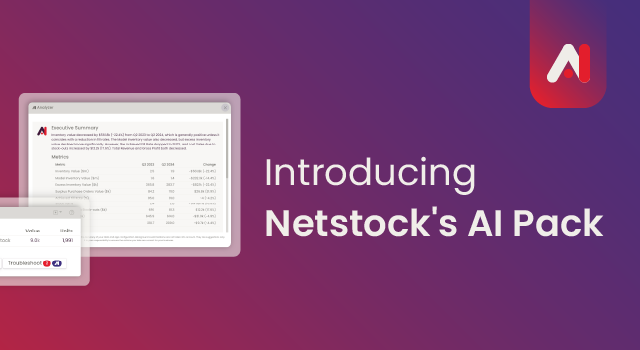Planning is a crucial function for any business, especially when it comes to ensuring that resources align with objectives. Effective demand forecasting plays a vital role in this process, helping businesses prevent stock-outs so products are available when needed. On the other hand, it also curbs overstocking, which reduces holding costs and the risk of obsolescence.
According to Netstock’s recent survey, excess stock now accounts for 38% of SMB inventory. This highlights the challenge many businesses face in managing their inventory effectively. By striking the right balance between inventory and demand, businesses can not only improve their cash flow and operational efficiency but also gain a powerful competitive edge.
Understanding inventory forecasting software
Inventory forecasting software helps businesses predict future inventory needs, enabling strategic decisions on pricing and promotions. By analyzing data such as past sales, market trends, and environmental factors, the software generates accurate forecasts that align customer demand with optimal inventory levels.
Accurate forecasting helps reduce storage, insurance, and obsolescence costs while ensuring product availability. Optimizing inventory not only improves cash flow but also frees up capital for other areas of the business.
Velocity Vehicle Care achieves 98% fill rate
Netstock helped smooth out the seasonal highs and lows. During the COVID-19 pandemic, Velocity Vehicle Care struggled with shipping delays and lost, unsent, or rerouted shipments. It was a tough time. However, they were able to re-forecast their estimated monthly demand based on the drop in business.
“We also extended the lead times and started working on a six-month lead time. We struggled a bit over the first half of this year, but we are now in a far better position with a 98% fill rate on orders. An improvement of over 10% in a disruptive climate is a considerable achievement.” – Velocity Vehicle Care
Key inventory forecasting software features to look for
When choosing inventory forecasting software, here are some features you should keep an eye out for:
Demand forecasting
Demand forecasting lays the foundation for sound inventory management. Forecasting allows organizations to plan inventories to meet demand as it happens. Common demand forecasting methods include:
- Time series analysis: Analyzes historical data to identify patterns and predict future demand.
- Causal models: Consider external factors like economic conditions, marketing efforts, or competitor actions.
- Machine learning algorithms: Use advanced analytics to improve accuracy by learning from new data.
Forecasting software must identify seasonal vs. flat or consistent demand. Advanced software automatically adjusts stock levels to meet seasonal peaks and troughs. These dynamic changes ensure you have the inventory ready for peak demand. You can also shed the stock before the low season.
Need flexible and collaborative forecasting capabilities?
Discover how Netstock’s demand planning solution injects predictability into its planning processes.
Automated reordering and purchase orders
Automated reordering simplifies replenishment by activating orders when stock reaches a predefined level. It reduces human errors and saves time. Businesses can use automated reordering to prevent stock-outs and maintain smooth operations.
Real-Time inventory tracking
Real-time inventory tracking ensures you have a clear view of current stock levels, and that all employees have an accurate up-to-date inventory data view. With a single view dashboard you can monitor and respond quickly to demand changes and manage inventory across various locations. The provided data should help you to make informed decisions and maintain efficient operations.
Need more inventory visibility?
Work from a single-view dashboard. View the top 5 SKUs under each KPI – like stock-outs, fill rate and excess stock, to identify urgent issues and prioritize actions with the greatest business impact.
Reporting and analytics tools
Comprehensive reporting and analytics tools can provide insights into demand trends and inventory and supply chain performance. Use the tools to analyze data, identify patterns, and improve business operations. Detailed reports track metrics that are vital for inventory optimization, like turnover rates, carrying costs, and service levels.
Need custom reporting?
Check out how Netstock lets you create custom reports tailored to your business needs.
Supplier management
An efficient supply chain depends on effective supplier management. Your forecasting software should provide the means to monitor performance and communicate more effectively. Good supplier management builds strong relationships and ensures timely deliveries.
Integration capabilities
Choose forecasting software that integrates with other systems, such as Enterprise Resource Planning, Point of Sale, accounting, and Customer Resource Management. With integrated software, your data will migrate from one system to another, creating a single data source. This reduces the need for manual data input and aids interdepartmental coordination.
Role of AI in inventory forecasting and planning
AI substantially contributes to inventory forecasting. Here’s how:
- Streamlining repetitive tasks: AI tracks inventory levels in real-time. When the stock drops to a pre-determined level the system automatically places replenishment orders. Automation removes the human element and cuts errors. Freed from repetitive processes, planners can concentrate on managing stock levels.
- Enhancing demand forecasting: AI can analyze vast amounts of real-time and historical data. Machine-learning algorithms recognize patterns and trends. This enables more accurate forecasting and allows planners to optimize stocks, lowering costs and risk. AI systems continuously learn from new data to refine and improve forecasting and respond to demand changes and market conditions.
- Integrated systems: AI-driven inventory management solutions, like those offered by Netstock, integrate with existing systems to provide real-time insights and actionable data.
Inventory forecasting methods
Here we’ll discuss two main forecasting methods.
Just-in-Time (JIT) Inventory
JIT focuses on reducing inventory levels by closely matching orders to production schedules and customer demand. Businesses avoid the costs of overstocking by receiving goods as they are needed. JIT requires highly efficient supply chain management and strong supplier relationships for timely deliveries.
Economic Order Quantity (EOQ)
The EOQ calculates the order quantity for the lowest total inventory cost. The EOQ aims to find the most cost-effective order size by balancing the costs of ordering too often with the costs of holding excess inventory. With this calculation, you can reduce total inventory costs, improve cash flow, and maintain stock levels that meet demand without overstocking.
Best practices for implementing inventory forecasting software
These best practices for successful forecasting software implementation will help you hit the ground running
Data accuracy and analysis
Effective inventory forecasting depends on data accuracy. The software relies on historical sales data, lead times, and other variables to create forecasts. Inaccurate or incomplete data can lead to errors in demand forecasting, and forecast errors can lead to stock-outs or overstocking. Regularly audit your data to ensure that all inputs are up-to-date, and integrate real-time data feeds to improve inventory forecasting.
Setting up procedures and KPIs
You can’t manage what you don’t measure. Carefully considered key performance indicators (KPIs) help you track forecasting performance. Include inventory turnover rate, order accuracy, fill rate, and stockout frequency in your KPIs.
Set up clear procedures for data input, forecast review, and order generation. Ensure that the software is working effectively with regular performance reviews. Use the KPIs to identify improvement areas, optimize inventory levels, and improve performance.
Adapting to market conditions
One of the primary benefits of inventory forecasting software is its ability to adapt to changing market conditions. Regularly update the software with the latest market data and quickly respond to supply chain disruptions to exploit this capability.
Challenges in inventory planning & forecasting
Inventory planners deal with challenges in planning and forecasting, with common pitfalls like:
- Inaccurate or incomplete data: Data gaps and inaccuracies affect the forecasts, leading to excess inventory or stock-outs.
- Supply chain disruptions: Whether due to global events or unreliable suppliers, these can cause significant problems in optimal inventory maintenance.
- Shifting trends: Rapid market trend adjustments or consumer preference changes can upset forecasts. If you fail to adapt to the changes you could sit with excess stocks of outdated items and insufficient stock of products in demand.
A proactive approach to these challenges will help you quickly recover. Here’s how you can respond appropriately to each challenge:
- Ensure accurate data: Accurate data ensures that your forecasts are based on reliable information. Automate manual data processes and integrate real-time data. Conduct regular data audits.
- Build strong supplier relationships: Strong relationships can reduce the impact of supply disruptions.
- Use advanced forecasting tools: AI-driven enhanced software can improve forecast accuracy. These systems analyze large amounts of data and respond to changes in demand with dynamic adjustments.
Grow your business with the right inventory forecasting software
SMBs worldwide are discovering the game-changing benefits of advanced forecasting systems, which automate routine tasks for more accurate forecasts and optimized inventory. The right inventory software helps you respond quickly to market changes, reduce inventory costs, and enhance customer satisfaction, ensuring your business maintains a strong market presence.




